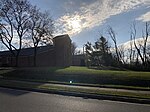Avenue Market
Buildings and structures in BaltimoreFood markets in the United StatesFood retailersMarket hallsMaryland building and structure stubs ... and 1 more
Upton, Baltimore

The Avenue Market, originally known as the Lafayette Market, is a historic marketplace built in 1871 in Upton, West Baltimore, United States. The market is on Pennsylvania Avenue and is near the Old West Baltimore Historic District. The market has seen multiple iterations, having been rebuilt after burning to the ground in 1953, renovated and given its current name in 1996, and renovated again in 2012. Another redevelopment is expected to begin in the summer of 2022.Upton–Avenue Market station in the Baltimore Metro SubwayLink system serves the area and includes the market in its name.
Excerpt from the Wikipedia article Avenue Market (License: CC BY-SA 3.0, Authors, Images).Avenue Market
Pennsylvania Avenue, Baltimore
Geographical coordinates (GPS) Address Nearby Places Show on map
Geographical coordinates (GPS)
| Latitude | Longitude |
|---|---|
| N 39.3037 ° | E -76.6357 ° |
Address
Pennsylvania Avenue 1631 H
21217 Baltimore
Maryland, United States
Open on Google Maps










